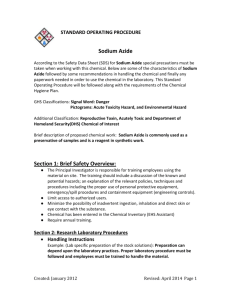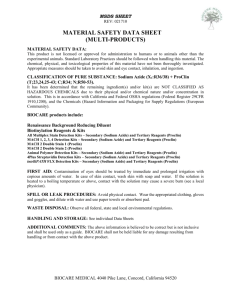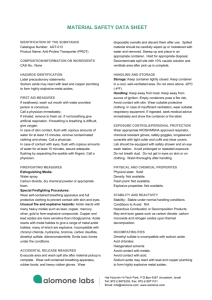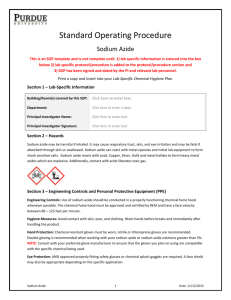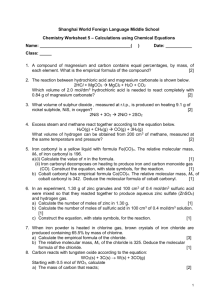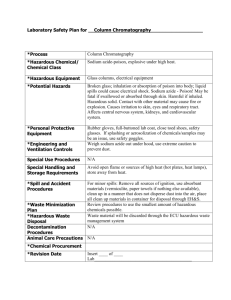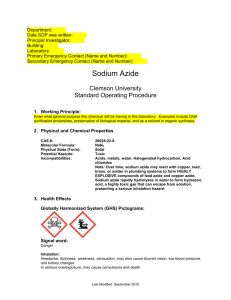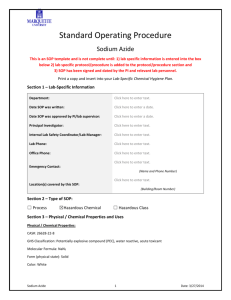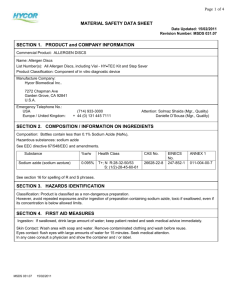Sodium Azide SOP Template
advertisement
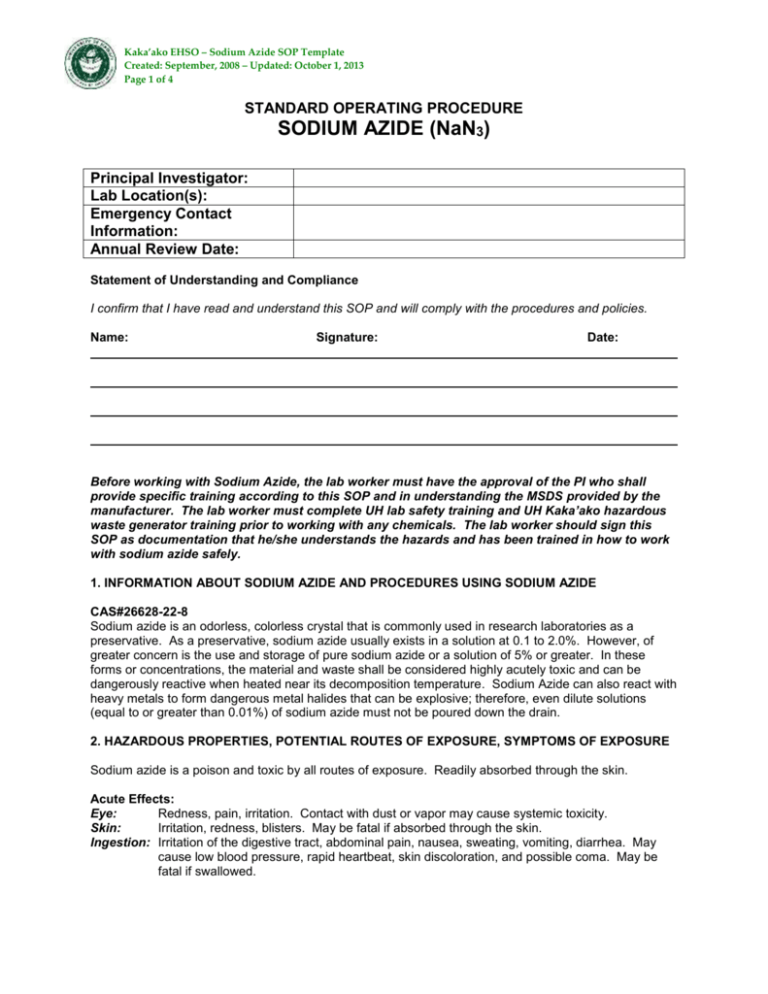
Kaka’ako EHSO – Sodium Azide SOP Template Created: September, 2008 – Updated: October 1, 2013 Page 1 of 4 STANDARD OPERATING PROCEDURE SODIUM AZIDE (NaN3) Principal Investigator: Lab Location(s): Emergency Contact Information: Annual Review Date: Statement of Understanding and Compliance I confirm that I have read and understand this SOP and will comply with the procedures and policies. Name: Signature: Date: Before working with Sodium Azide, the lab worker must have the approval of the PI who shall provide specific training according to this SOP and in understanding the MSDS provided by the manufacturer. The lab worker must complete UH lab safety training and UH Kaka’ako hazardous waste generator training prior to working with any chemicals. The lab worker should sign this SOP as documentation that he/she understands the hazards and has been trained in how to work with sodium azide safely. 1. INFORMATION ABOUT SODIUM AZIDE AND PROCEDURES USING SODIUM AZIDE CAS#26628-22-8 Sodium azide is an odorless, colorless crystal that is commonly used in research laboratories as a preservative. As a preservative, sodium azide usually exists in a solution at 0.1 to 2.0%. However, of greater concern is the use and storage of pure sodium azide or a solution of 5% or greater. In these forms or concentrations, the material and waste shall be considered highly acutely toxic and can be dangerously reactive when heated near its decomposition temperature. Sodium Azide can also react with heavy metals to form dangerous metal halides that can be explosive; therefore, even dilute solutions (equal to or greater than 0.01%) of sodium azide must not be poured down the drain. 2. HAZARDOUS PROPERTIES, POTENTIAL ROUTES OF EXPOSURE, SYMPTOMS OF EXPOSURE Sodium azide is a poison and toxic by all routes of exposure. Readily absorbed through the skin. Acute Effects: Eye: Redness, pain, irritation. Contact with dust or vapor may cause systemic toxicity. Skin: Irritation, redness, blisters. May be fatal if absorbed through the skin. Ingestion: Irritation of the digestive tract, abdominal pain, nausea, sweating, vomiting, diarrhea. May cause low blood pressure, rapid heartbeat, skin discoloration, and possible coma. May be fatal if swallowed. Kaka’ako EHSO – Sodium Azide SOP Template Created: September, 2008 – Updated: October 1, 2013 Page 2 of 4 Inhalation: Severe irritation of the respiratory tract with sore throat, coughing, nasal stuffiness, blurred vision, shortness of breath and delayed lung edema. The vapor of hydrazoic acid may be present where sodium azide is handled. Symptoms of acute exposure to hydrazoic acid include eye irritation, headache, dramatic decrease in blood pressure, weakness, pulmonary edema and collapse. Routes of Exposure Sodium azide may enter the body through all routes of exposure. Chronic Effects: Chronic exposure to sodium azide may result in liver and kidney damage. Repeated exposure may cause damage to the spleen. Laboratory studies have shown mutagenic effects, development of tumors in animals, and blood effects. Cancer Hazard: It is a mutagen and should be treated as a possible carcinogen. Reproductive Hazard: Unknown. Physical Hazard: Sodium azide rapidly hydrolyzes in water, when mixed with water or an acid, to form hydrazoic acid, a highly toxic and explosive gas. It is thermally unstable and if heated to 275ºC, sodium azide may undergo violent decomposition. Sodium azide also form explosive compounds when it comes in contact with or dries on metal surfaces. It can also react with metal pipes in laboratory sinks, traps and drains, so do not dispose of down the sink! If introduced to the waste water treatment system in large volume or in high concentrations, the desirable anti-bacterial characteristics of this chemical can damage the water treatment process of your city and county. It will also react with metal spatulas and metal lab equipment to form shock sensitive salts. It reacts with lead, copper, silver, gold and metal halides to form heavy metal azides which are explosive. 3. PERSONAL PROTECTIVE EQUIPMENT Nitrile disposable gloves. Double-gloving is recommended when working with pure sodium azide or sodium azide solutions greater than 5%. Change gloves frequently and when contaminated, punctured, or torn. Wash hands immediately after removing gloves. Safety glasses with side shields or chemical splash goggles shall be worn. A laboratory coat should be worn when working with this chemical. A chemical-resistant apron with attached sleeves should be worn over the laboratory coast if working with large amounts of solution of if there is a greater potential of slashing during the procedure. Closed toe shoes are required at all times when working in the laboratory. 4. ENGINEERING/VENTILATION CONTROLS Work with sodium azide in a properly operating and certified chemical fume hood. Work at least 6” inside the hood, never place your head in the hood, set the sash at the lowest position possible (if using the horizontal sliding sashes do not open past the labeled positions). Safety shower and eye wash stations should be easily accessible when sodium azide is used. 5. SPECIAL HANDLING PROCEDURES AND STORAGE REQUIREMENTS Kaka’ako EHSO – Sodium Azide SOP Template Created: September, 2008 – Updated: October 1, 2013 Page 3 of 4 Do not store on metal shelves or use metal items (spatulas) to handle sodium azide. Store in tightly closed containers in a cool, well-ventilated area away from heat, air, light and moisture. Sodium azide and all other acutely toxic materials should be stored in a secondary container and locked in a cabinet, refrigerator or drawer when authorized personnel are not present. A refrigerator storing sodium azide must be labeled on the outside with a caution sign noting the presence of sodium azide and its hazards. Store away from metals, acids, carbon disulfide, bromine, chromyl chloride, sulfuric acid, nitric acid, hydrazine and dimethyl sulfate. Use only in a certified chemical fume hood. Sodium azide powder should be purchased in the smallest practical amount. Whenever possible, sodium azide should be purchased as a pre-mixed stock solution of less than 5%. Transport chemicals in closed containers, in the smallest amounts possible, and use aids such as carts, chemical transport carriers, etc. It is highly recommended that all chemicals be stored below eye level so cracking or leaking containers are immediately visible and there is less potential for chemicals falling onto lab workers when pulling from shelves. Whenever handling pure sodium azide powder or concentrated solutions of 5% or more, that may require assistance in case of a spill or accident, it is recommended that a second trained individual be present in the lab or in the vicinity. Wash hands thoroughly after handling (even if gloves were used). 6. PROCEDURES ****Modify this section to reflect your lab specific procedures! Absorbent bench paper should be used with handling sodium azide. Bench paper should be disposed via EHSO upon contamination from spilling or after usage. Handling Sodium Azide o Wear appropriate PPE (gloves, eye protection, lab coats, covered toe shoes). o Change gloves after handling. o Waste container should be properly labeled and stored in chemical fume hood until disposal. o Work in a chemical fume hood. o All general safe work practices should be followed when working with sodium azide (i.e. no eating, drinking, chewing gum, etc). 7. SPILL AND ACCIDENT PROCEDURES Do not attempt cleanup if you feel unsure of your ability to do so or if you perceive the risk to be greater than normal laboratory operators. Call Kaka’ako EHSO 692-1854 / 692-1855 for assistance. Isolate the area to prevent the spread of contamination (e.g. close doors to affected area, post warning signs, alert others in immediately vicinity to evacuate). Vacuum or sweep up material and place into a suitable disposal container (non-metal). Avoid generating dusty conditions. Wear a self contained breathing apparatus and appropriate personal protection. Do not flush down the drain. Sodium azide may react with copper, lead, brass, or solder in plumbing systems to form an accumulation of the highly explosive compounds of lead azide and copper azide. Do not let this chemical enter the environment. Report all incidents or near misses to Kaka’ako EHSO and complete the appropriate Incident Forms. Small spills (in a chemical hood): Don appropriate PPE. Sodium azide crystals should be swept up and surfaces cleaned with pHadjusted water (pH greater than 9.0). Cover spills of sodium azide solution with absorbent material, and clean surfaces with pH-adjusted water. Collect spilled material and clean up Kaka’ako EHSO – Sodium Azide SOP Template Created: September, 2008 – Updated: October 1, 2013 Page 4 of 4 material into appropriately labeled waste container. All spill clean up material should be disposed of as hazardous waste. Large spills / Spills outside of a chemical hood: Notify others in room of spill. Evacuate room/immediate area. Call Security and Kaka’ako EHSO. Close doors and post warning signs at entrances/exits notifying others of spill. Prevent unnecessary entry into area. Provide assistance and information to spill responders. Report all spills (minor and major) and any near misses to Kaka’ako EHSO. 8. FIRST AID MEASURES Eye Contact: Immediately flush eyes with plenty of water for at least 15 minutes, lifting lower and upper eyelids occasionally. Get medical attention immediately. Skin Contact: Wipe off excess material from skin, then immediately flush skin with plenty of soap and water for at least 15 minutes. Remove contaminated clothing and shoes. Get medical attention immediately. Wash clothing before reuse. Ingestion: Induce vomiting immediately as directed by medical personnel. Never give anything by mouth to an unconscious person. Get medical attention immediately. Inhalation: Remove from exposure and move to fresh air. If breathing is difficult, give oxygen. Do not use mouth-to-mouth resuscitation if victim ingested or inhaled substance. Get medical attention immediately. * Note to physician: Accidental ingestion of sodium azide is potentially life-threatening. Treatment includes gastric lavage, followed by sodium catharsis. EKG and blood pressure monitoring and support are recommended. 9. WASTE DISPOSAL PROCEDURES Sodium azide is listed as a 6.1 poison hazardous material and should be disposed of properly to Kaka’ako EHSO. Gloves, test tubes, pipette tips, and paper towels, etc. that are contaminated with sodium azide should be also collected for hazardous pickup by Kaka’ako EHSO. Drain disposal of sodium azide solutions is not permitted. 10. MSDS LOCATION ****Where is this located, as an attachment to the SOP, in the MSDS folder, etc? Must have an MSDS, preferably manufacturer specific, specific for each type of sodium azide used (per CAS#). References: Information contained in this SOP was gathered from the following sources: University of Medicine & Dentistry of New Jersey, Fisher Scientific, Sigma Chemical Co., Mallinckrodt Baker Inc.
